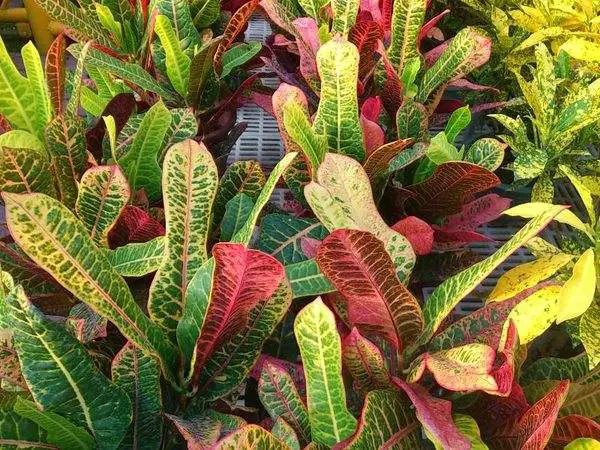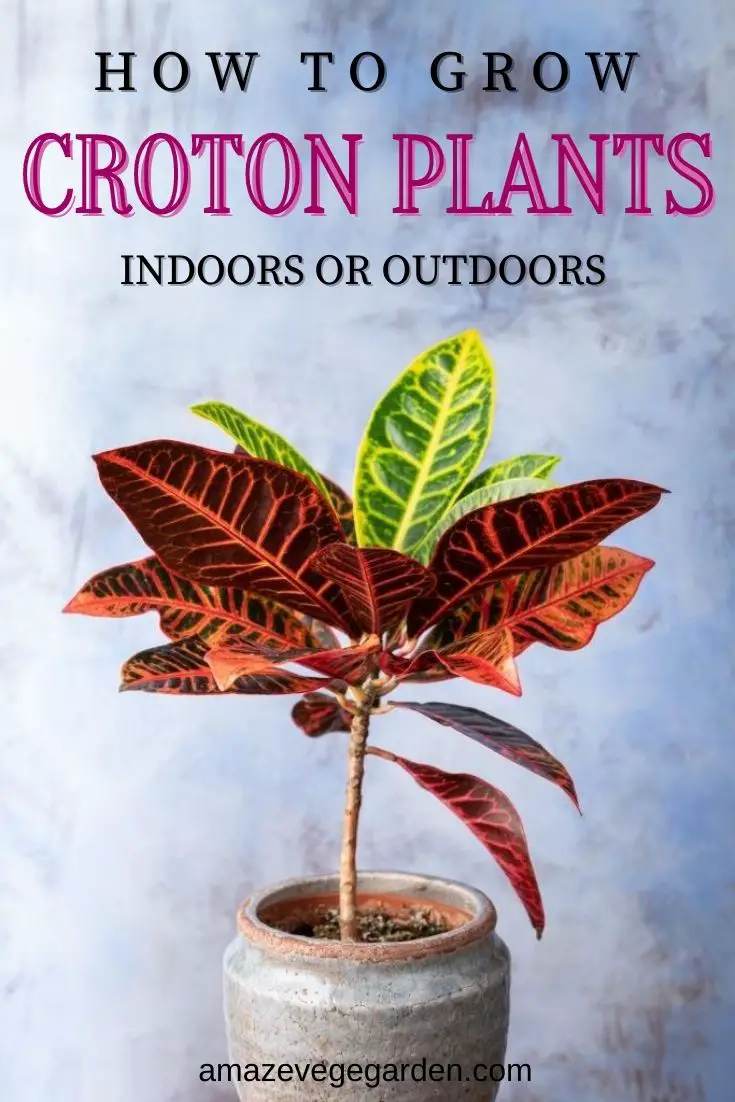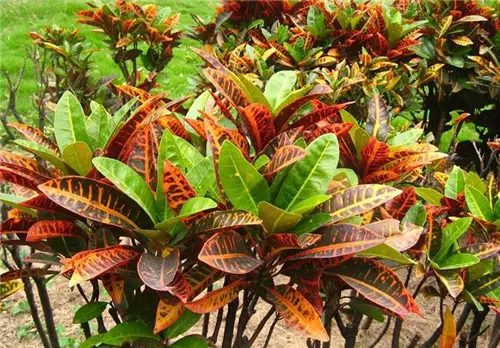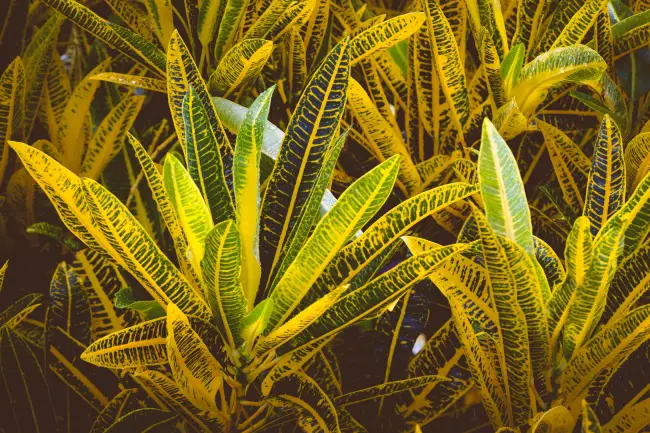Welcome fellow plant lovers. Are you looking for an easy-to-care-for, vibrant addition to your home? Look no further than the croton. This beautiful and unique houseplant is a popular choice for many indoor gardeners and it’s not hard to see why. With its wide range of leaf shapes, sizes, colors, and textures, the croton offers something special that other plants simply can’t provide. So if you’re thinking about adding a bit of flair to your living space with this tropical beauty, then let me take you through everything you need to know on how to grow a croton plant successfully.
This guide will cover all aspects of caring for your new plant including information on light requirements, soil type, watering needs, temperature preferences, pot size selection, and more. We’ll also discuss common problems associated with growing crotons such as pest infestation or disease so that you can be prepared in case any issues arise during their care.
So whether you just picked up a few cuttings from the nursery or are ready to invest in some larger specimens for your collection – I’ve got all the help and advice necessary for getting them off to a good start.
Overview Of Croton Plants
Croton plants are a vibrant addition to any garden. Showy foliage and an impressive array of colors make crotons the perfect houseplant or outdoor accent for your home. They’re tough, easy to care for and look stunning in all kinds of gardens. With their bright leaves that come in various shades of red, yellow, orange, and green, they create a tropical feel wherever they’re planted.
Crotons are great as long-term investments because they can last up to 15 years if taken care of properly. Plus, with some pruning and maintenance, these plants will keep producing new growth and color year after year. So why not add this gorgeous plant to your landscape today? From its unique shape to its eye-catching colors, crotons have something special that adds beauty and character to your space no matter where you choose to put them.
Varieties
Croton plants come in a large variety of sizes, shapes, and colors. As such, there are many different types to choose from when deciding which croton plant is best for your home or garden. Some popular varieties include the ‘petra’, ‘gold dust’, and ‘Zanzibar’ varieties.
The petra variety has dark green leaves with yellow veins while the gold dust has variegated yellow, cream, and pink foliage that’s sure to brighten up any room. Lastly, the Zanzibar is a more compact variety that grows smaller than other Crotons but still manages to provide an eye-catching display of color with its deep burgundy leaves.
No matter what type of croton plant you decide on, they all require similar care so make sure to research each variety thoroughly before making your selection.
Obtaining Croton Plant Seeds Or Cuttings
Croton plants can be propagated from seeds or cuttings. While growing them from seed may take more time, it is the preferred method for obtaining new crotons. Here are some tips on how to get started:
- Purchase croton plant seeds online or at your local nursery. The most popular varieties have been bred over generations and will produce a reliable crop of healthy plants.
- Collecting cuttings is another option if you know someone who has an established Croton plant in their garden. Cut off 1-2 inches of stem with several leaves attached and place into the water until roots form (about 4 weeks). Once rooted, transplant into the potting mix.
- Propagating by air layering is also possible but requires careful attention to detail to ensure successful rooting occurs before cutting the branch away from the mother plant.
Soil Requirements For Growing Croton Plants
Croton plants are the ultimate show-stoppers in any garden. With their vibrant colors, they can instantly add life to a dull space and create an exquisite display of beauty. But before you can enjoy this incredible sight, there’s one key factor that must be taken into consideration – soil requirements for croton plants.
The perfect soil should have excellent drainage as well as enough organic matter for optimal growth. It also needs to hold moisture without becoming soggy or compacted. To ensure your crotons thrive, it’s best to use a combination of potting mix and compost when planting them outdoors. Alternatively, you could opt for a container filled with rich loam mixed with peat moss and sand. Whichever option you choose, make sure your crotons get all the nourishment they need.
You need to know that crotons prefer slightly acidic soils so adding some sulfur amendments or wood ash is beneficial if needed. With proper care and attention to its soil needs, your stunningly beautiful croton plant will look picture-perfect in no time.

Sunlight Requirements For Growing Croton Plants
Croton plants need plenty of sunlight to grow and thrive. They are native to tropical climates, so they can tolerate full sun or partial shade. If you live in a cooler climate, it’s best to keep them out of direct sunlight during the hottest part of the day. Place your crotons near an east-facing window for maximum light exposure. You’ll also want to rotate your pots every few days so that all sides get adequate amounts of light.
When growing indoors, use fluorescent lamps about 12″ above your plants for optimal growth. Make sure to provide at least 10 hours per day with the lights on, as this will help promote healthy foliage growth and vibrant colors from their leaves. You might even consider investing in a specialized plant lamp that emits a spectrum specifically designed for photosynthesis and proper leaf development.
Your croton plants should be placed in areas where there is ample air circulation as well; otherwise, fungal diseases may develop due to high levels of humidity within their environment. With these tips in mind, your houseplants should have no problem getting enough light.
Watering And Fertilizing Croton Plants
Watering and fertilizing your croton plants can be likened to dance – you must find the right rhythm for it to work best. Just as sunlight requirements are essential, so is finding the perfect balance of water and nutrients for them to thrive.
When watering your croton plant, make sure that you moisten the soil thoroughly until moisture starts coming out from under the pot – never let it become soggy or overly dry. The frequency with which you should water depends on the season; during hot months, they will require more frequent watering than in colder times when less is needed. In addition, if you notice yellowed leaves or wilting stems then try adding some extra humidity around the plant by misting it regularly.
Fertilizing plays an important role in keeping your croton looking its healthiest. When applying fertilizer, use one specifically made for houseplants every two weeks during spring and summertime while keeping away from off-season feeding entirely. Make sure not to overdo it though; too much fertilizer can cause salt burn which results in discolored foliage and the eventual death of your beloved plant.
With patience and proper care, these magnificent plants will surely reward their owner with dazzling colors that bring life into any room or garden space.
Pruning And Propagation Practices
Pruning and propagation practices are essential for maintaining healthy croton plants. Proper pruning encourages fullness, increases light penetration to the inner leaves, and helps to keep your plant looking its best. Here are a few tips:
- Prune regularly during the growing season using clean shears or scissors.
- Don’t be afraid to remove overgrown branches – this will encourage new foliage growth from beneath the canopy of existing branches.
- Propagate by taking cuttings in spring or summer when temperatures are milder.
It’s important to note that crotons can become leggy if not pruned correctly; however, regular pruning throughout the year will help promote lush foliage with multiple colors. If you’re unsure about how much to prune, it’s always better to err on the side of caution and take smaller cuts than remove too much at once.
Common Issues When Growing Croton Plants
Growing Croton plants can be a rewarding experience, but there are several common issues to watch out for. The first issue is improper light exposure. Crotons prefer bright, indirect sunlight and should not receive too much direct sun or they may become scorched and die. If you notice any discoloration of the leaves or wilting, it’s likely your plant isn’t getting enough light.
The second most common problem with crotons is overwatering or underwatering. Too little water will cause the leaves to yellow and drop off, while too much water will lead to root rot due to poor drainage in the soil. Make sure you check the soil every few days until you get an understanding of when it needs watering. Lastly, like many other houseplants, pests such as mealybugs, aphids, spider mites, and scale insects can damage crotons if left untreated.
To prevent these types of problems from occurring in your croton plant, make sure you provide it with proper care including adequate light levels and appropriate watering schedules that meet its needs.
How To Prevent Pests And Diseases
Preventing pests and diseases from affecting your croton plants is like playing a game of chess. You must be one step ahead of the unwanted guests to keep them away. The first line of defense for any plant should always be prevention. If you can avoid certain situations, it will help save time and money in the long run.
The environment plays an important role when it comes to keeping your crotons healthy. Be sure they are planted in well-drained soil that has been amended with organic matter such as compost or manure. This will create ideal growing conditions while helping to prevent problems associated with too much moisture or fertilizer burn. Additionally, make sure your plants have adequate space between each other so air can circulate freely throughout the area.
Stay on top of regularly inspecting your crotons for signs of distress such as wilting leaves or discoloration. At this point, it’s best to take action quickly by removing any affected areas before further damage occurs.
Potting And Repotting Instructions
Moving on from the pest and disease prevention advice, proper potting and repotting techniques are essential for growing healthy croton plants. When first planting a croton plant in its new home, it is important to use well-draining soil that contains an organic material like peat moss or composted leaves. The container should also have sufficient drainage holes at the bottom and be slightly larger than the root system of the plant.
When transplanting an established croton plant into a new container, start by gently removing it from its existing one along with as much of the original soil as possible. It may be necessary to prune away any damaged roots before transferring them to their new home. Once again, ensure there is enough room for the root system to grow without becoming too cramped, and add plenty of organic matter to keep them nourished.
Water regularly but make sure not to overwater your croton plant – they are sensitive to soggy conditions.
Container Gardening With Croton Plants
Containers offer an ideal environment for growing croton plants. They create a microclimate that can be carefully managed to ensure the right conditions of temperature, light, and moisture. For those looking to bring some color into their homes and gardens quickly, container gardening with croton is the perfect way to do it.
First, choose the correct pot size for your plant. A container should not be too big or small; if it’s too large, there may not be enough nutrients in the soil for proper growth; too small and it will become root-bound very quickly. When planting in containers, use a well-drained soil mix designed specifically for houseplants or succulents. Add organic matter like compost or peat moss to give extra nutrition and aeration to the soil.
Second, make sure you place your croton in an area with plenty of bright indirect sunlight – this could be near a window or outdoors on a patio where it won’t get direct sun but still has access to ample light throughout the day. If needed during the summer months when temperatures are higher than usual, provide shade protection from the intense afternoon sun by partially covering your planter with burlap or cheesecloth fabric.
Watering correctly is essential when caring for crotons grown in pots outside as they tend to dry out faster than garden beds due to more exposure to wind and heat. Check the top layer of soil every few days and water deeply when necessary– once per week at a minimum – allowing time between watering sessions so that excess liquid can drain off completely before adding more water again. Doing so helps prevent overwatering which can result in wilting leaves and other problems related to poor drainage such as root rot.
Tips For Growing Indoors
Growing croton plants indoors can be a challenging task. However, with the right tips and tricks, you can make sure your indoor crotons thrive. When growing croton indoors it’s important to provide ample light. Place pots near windows that get at least 4-6 hours of direct sunlight per day. If this isn’t possible, then using an artificial grow light is recommended. Crotons also prefer temperatures between 65-75 degrees Fahrenheit (18-24 Celsius).
It’s especially important that humidity levels remain high when growing them indoors; try misting or even setting up a humidifier in order to increase moisture levels in the air. You should water regularly but don’t overdo it as too much moisture will cause root rot – use good drainage so excess water can escape quickly.
Harvesting And Storing Croton Leaves
Harvesting croton leaves is an important step in growing and caring for these vibrant plants. To ensure that your plant remains healthy and happy, it’s essential to harvest the leaves at the right time. The best time to harvest croton leaves is when they reach their peak of maturity—about three months after planting.
When harvesting, use a pair of sharp scissors or pruning shears to snip off individual stems with several leaves on them. Try not to damage other parts of the plant while cutting away mature leaves, as this can cause stunted growth later on. After harvesting, store the freshly-cut crotons in a cool, dry place until you’re ready to use them. Storing them properly will help preserve their color and vibrancy longer than if left out in the open air.
Decorating With Crotons
Croton plants are not only an excellent choice for indoor and outdoor gardens but they can also be used to decorate your home. With their brightly colored foliage in a variety of hues, crotons add a beautiful splash of color wherever you put them. From the living room to the bedroom or even on the patio, with some creative placement and thoughtful maintenance, these bold plants will brighten up any space.
The trick is finding just the right spot for your croton plant that gets enough light without too much exposure to hot sun or cold air drafts. This way it’ll receive adequate sunlight while avoiding extreme temperatures which could burn its leaves or cause wilting. The ideal temperature range should stay between 50-90 degrees Fahrenheit during the day and 40-70 degrees at night. Once you’ve found the perfect position, it’s time to start decorating.
You can combine different varieties of crotons to create unique arrangements around your home. Place them together in one pot or use separate pots to display individual specimens – either way, works well. For example, try mixing variegated croton (Codiaeum variegatum) with rainbow croton (Codiaeum variegatum pictum), as two contrasting colors side by side makes for an eye-catching combination when placed against walls or furniture pieces like bookshelves or cabinets.
Ways To Preserve A Mature Plant
Once your croton plant has matured, preserving it is key to keeping its vibrant colors and growing habits. Fortunately, the process of protecting a mature plant isn’t difficult – just a few simple steps.
You’ll want to ensure that your croton gets enough sunlight each day. A minimum of six hours per day should be sufficient; otherwise, your plant may become leggy or discolored. It’s also important to water it regularly but not too much – overwatering can cause root rot and other illnesses in plants like these. Crotons prefer soil with good drainage so make sure you create an environment that allows excess moisture to escape quickly.
Pruning is essential if you want your croton to look its best over time. Remove any yellow or wilted leaves right away and cut off dead stems occasionally as well. This will help prevent the disease from spreading through the rest of the foliage and keep your plant healthy for years to come.
Final Thought
Growing croton plants is not as difficult as it may seem. With the right knowledge and tips, anyone can be successful in growing these beautiful tropical plants year-round. Once you have chosen a variety of your preference and understand what they need to thrive, you’ll find that taking care of them isn’t too challenging. Sunlight, soil, temperature, and humidity are important aspects to keep in mind when caring for crotons.
Additionally, harvesting the leaves will help promote growth while decorating with them can create an eye-catching display indoors or outdoors.
Finally, preserving mature plants by cutting off pieces of stems and replanting them will ensure their longevity. I hope this article has given you the confidence needed to start your own journey into growing croton plants.



